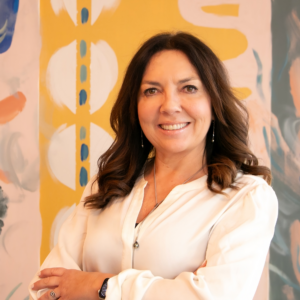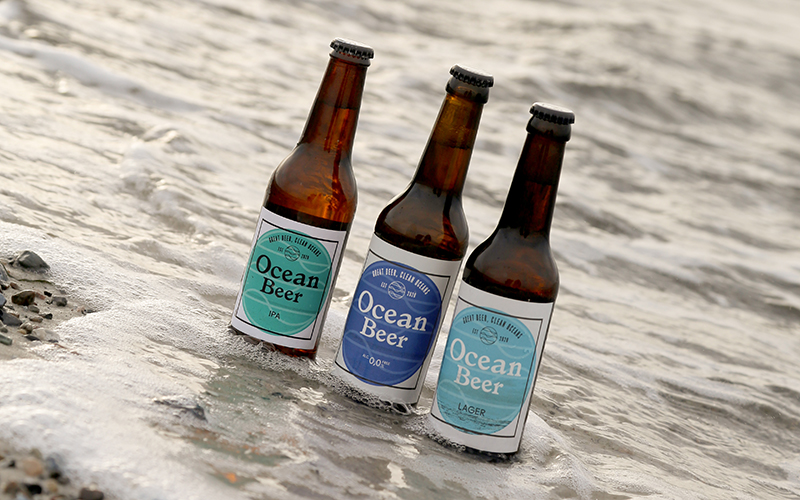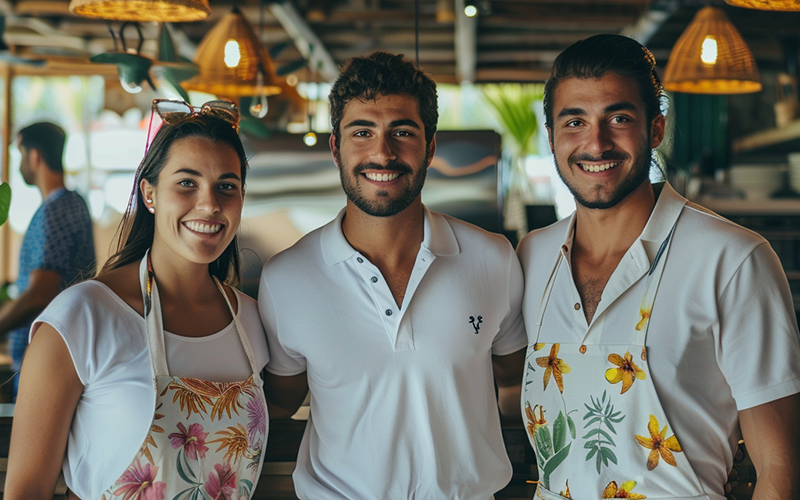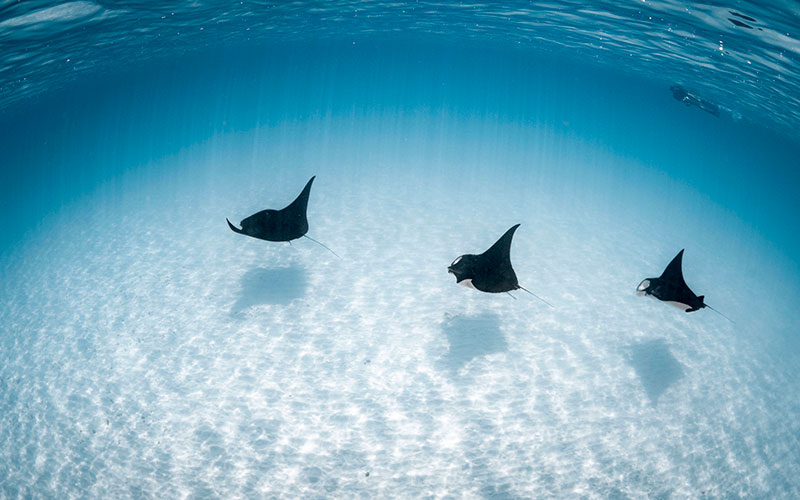One Man's Quest to Heal the Ocean—And Maybe Save the World
April 20th, 2023
Enric Sala—marine ecologist, conservationist, and ocean advocate—is standing under a life-size replica of a Northern Atlantic Right Whale at the natural history museum in Washington, D.C., and the air outside is smudged with wildfire smoke drifting down from Canada. It’s not surprising that Sala wants to talk about the smoke, or about whales. Their poop, however, is an unexpected twist. According to Sala, whale excrement, or, more precisely, the lack of it, has a role to play in the choking miasma that has forced my interview with one of the world’s foremost ocean explorers indoors instead of out on a boat.
It may seem like a stretch, the kind that relegates environmentalists deep into woo-woo territory, but as our conversation unfolds, it starts making sense. Whale poop fertilizes ocean plankton. The plankton reproduces rapidly, absorbing carbon dioxide as it photosynthesizes sunlight. Eventually it sinks to the seafloor, trapping the planet-warming gas in layers of sediment. Fewer whales means less plankton sequestering CO, leaving more in the atmosphere. That means more of the heat driving the wildfires that have smoked out much of North America.
“Suddenly, we’re seeing that the impacts of climate change are not something that is going to be suffered by somebody else,” says Sala. “It’s here.” And so it is, in the wildfires, heat waves, and floods that have made the weather of summer 2023 some of the most extreme on record. Greater biodiversity, whether it is found in the ocean’s whale populations or the old-growth forests that also store carbon, can help mitigate the effect of burning fossil fuels much more cheaply than any new technology, he says. “The more nature we have, the more nature will be able to absorb our impacts.”
Sala’s links between healthy ocean ecosystems and human benefits like carbon sequestration are backed up by science that he has either committed to memory or conducted himself. But it’s the ability to break scientific complexity into simple concepts that even landlubbers can comprehend that makes him so effective as an ocean advocate, helping rally global governments to commit to protecting 30% of their coastlines and ocean territories by 2030. His Pristine Seas project, sponsored by the National Geographic Society, has identified dozens of the ocean’s most biodiverse hot spots in an effort to call for their protection. Already he has managed to get 2.5 million sq. mi. (6.5 million sq km) of coastline and ocean set aside in 26 marine protected areas (MPAs)—an expanse twice the size of India—where fishing, dumping, mining, and other destructive industries are prohibited.
On May 24, Pristine Seas’ scientific-research ship the E/V Argo lifted anchor for its most ambitious undertaking yet: a five-year expedition to the remote tropical Pacific, where Sala plans not only to chart the world’s biggest ocean from its unplumbed depths to its more familiar shores, but also to document the complex links between marine ecosystems and the lives they support on land in order to build a case for their conservation.
The ocean needs that help more than ever. The morning of our meeting, the European climate-monitoring agency reported that May 2023 had seen the highest ocean temperatures on record, increasing ocean acidity, weakening marine ecosystems, and forcing coral polyps to expel their colorful symbiotic zooxanthellae algae in a near-death phenomenon called bleaching. By the end of July, waters off the coast of Florida had reached Jacuzzi temperatures, and volunteers were racing to transfer fragile coral sprouts to indoor aquariums before they cooked to death. According to the National Oceanic and Atmospheric Administration (NOAA), about 40% of the world’s oceans are currently experiencing a marine heat wave, with as much as 50% forecast for September.
The ocean has already absorbed more than 90% of the planet’s greenhouse-gas-fueled warming, explains Sala, “but it will not be able to absorb our impacts for much longer without serious consequences.”
Still, says Sala, there is hope. His research has proved again and again that given the space to recover undisturbed from human exploitation, nature can bounce back. “A marine protected area cannot make that water cooler, cannot protect from warming, but what we know is that fully protected areas are more resilient.” He has watched pristine reef systems, bleached white by marine heat waves, recover within five years—but only when they have their full cohort of predators like sharks, along with the smaller inhabitants they prey upon. A reef, he says, isn’t just made up of coral. It is a delicately balanced ecosystem that includes bacteria, algae, plants, clams, crabs, urchins, herbivores, and the carnivores that keep them all in check. Take one element out, and the entire system becomes unstable. “You board a plane, and the pilot informs you that five screws are missing, but you don’t know from where. Would you still fly?” he asks.
Sala’s solution for protecting the ocean from rising heat is simple: identify the richest areas of biodiversity and protect them from human intervention. Left alone, the resulting abundance will eventually spill over into unprotected zones, stocking new areas with fish that can be harvested for human consumption, while allowing for the evolution of genetic adaptation to a changing climate. MPAs, says Sala, are like an interest-bearing savings account. As long as you don’t touch the principal, you can live off the interest. “The only way to get more from the ocean is to have more life in the ocean,” says Sala. “And the only way to have more marine life is to set some places aside so it can thrive. It’s as simple as this.”
As an avid snorkeler growing up close to the near barren waters of Spain’s Costa Brava, Sala always assumed that the lush, underwater gardens of his favorite Jacques Cousteau documentaries could be found only in faraway tropical paradises. A chance scuba lesson in the Medes Islands marine park, one of Spain’s first MPAs, taught him that the Mediterranean could be just as much an underwater wonderland when it was protected from the region’s industrial fishing fleets. “Everything that was missing from the sea of my childhood was there,” he recalls. “The grouper, the sea bass, the scorpion fish, octopus, sea bream.”
That epiphany sparked an interest in marine conservation, and, with a Ph.D. in ecology, he went on to help establish the Center for Marine Biodiversity and Conservation in 2000 at the Scripps Institution of Oceanography, in La Jolla, Calif. But despite his tenured position, generous research grants, and the opportunity to work with the best ocean scientists in the world, he felt something was missing. “The places that I was studying were falling under the force of the relentless human sledgehammer,” he wrote in his 2020 memoir, The Nature of Nature: Why We Need the Wild. “Corals and seagrasses were dying everywhere, and fish were being taken out of the water faster than they could reproduce. Lush underwater gardens full of large animals were being turned into dead reefs overgrown by brown algae and murky jellyfish dystopias … I realized that all I was doing was writing the obituary of ocean life.” He felt, he says, like a doctor telling his patient how they would die, without offering a cure. So he quit, and went in search of one.
Since 2008, the program has conducted 38 expeditions, produced 30 documentaries, and published more than 250 peer-reviewed studies that have upended long-held assumptions about marine ecosystems, including the power of highly protected areas to rapidly restore depleted fish, coral reefs, and kelp forests in adjacent waters. In a 2021 paper for Nature, Sala demonstrated that protecting 30% of the ocean would also deliver benefits for commercial fisheries and carbon sequestration. He identified key areas that, if protected, would provide the most benefit in terms of nature conservation, food production, and climate mitigation, a kind of more-bang-for-your-protection-buck checklist that he is now trying to persuade local governments to implement. Overall, Pristine Seas has midwifed a total of 26 MPAs into existence, helping raise the percentage of protected ocean from 1% to 8%.
That’s still significantly less than the 30% that scientists say is necessary to protect ocean biodiversity. Sala visibly flinches when reminded of that shortfall, and acknowledges the pressures piling up since he started 15 years ago, from a quadrupling of plastic waste to higher temperatures and increased fishing pressures. “Now I’m working on the cure, but the patient is getting worse and worse,” he concedes. “We fix the lungs. But oh, now there’s something wrong with the liver. Oh, and there is a blood clot. So yeah, it’s a Sisyphean task. But that’s what makes me keep going. I don’t see a bigger purpose than working to save life on earth.”
Pristine Seas was inspired by a National Geographic story about an explorer who trekked across central Africa and persuaded the President of Gabon to create a chain of national parks to protect the region’s wildlife. Sala wondered if the same could be done for the oceans. In 2007, Sala approached the National Geographic Society with a proposal to combine exploration, research, policy, and documentary film to build a case for local governments to establish national marine protected areas. He envisioned Pristine Seas as a kind of scientific SWAT team, refining our understanding of ocean life, by sending divers, submersibles, and cameras into waters previously unplumbed by research, and working with economists, ecologists, and climate scientists to calculate the value of preserving what they found.
In a 2009 expedition to Kiribati’s Southern Line Islands, a chain of uninhabited atolls 1,800 miles southwest of Hawaii, Sala found reefs that had never seen pressure from commercial fisheries, a “thriving coral jungle full of large fish.” Before then, he says, scientists “had no idea what pristine reefs looked like.” In 2015 and 2016, disaster struck. A marine heat wave triggered coral bleaching in more than half the reef. Sala thought he was witnessing the destruction of one of the ocean’s last intact coral colonies. But a return visit in 2022 demonstrated a “miraculous” recovery. Coral was growing back, and the fish were as plentiful as they had ever been. “It recovered like a phoenix,” says Sala.
Documenting the reef’s recovery wasn’t enough. Sala wanted to understand why those coral survived the heat, when so many other reefs did not, and how that recovery could be replicated elsewhere. Sala theorized that grazing fish had kept the bleached coral free of the brown algae that usually takes over, enabling the coral polyps to start growing again. In June, Pristine Seas returned to the area in one of the first stops of its new Pacific expedition, in part to test Sala’s hypothesis. Was it the presence of large numbers of fish? Or because larvae from other, less affected corals were able to take root among the ruins? Had the surviving corals evolved some sort of heat resistance? “If we believe that high protection is a key ingredient for coral resilience, we need the data,” he says.
One of the most effective components of Sala’s Pristine Seas expeditions is the opportunity to offer a front-row seat for the ocean’s underwater marvels to the people who can make a difference. “We take Presidents, Ministers with us. They come out of the submarine saying, ‘This was the most transformative experience of my life,’” says Sala. Once they make the emotional connection, Sala presents them with the economic case for protection, and the policy proposals that help them sell it to their people. After going out with Pristine Seas in 2022, then Colombian President Iván Duque more than doubled the country’s marine protected areas, bringing it within reach of the 30% goal, and joining forces with regional neighbors Ecuador, Costa Rica, and Panama to establish the largest protected marine zone in the western hemisphere, if not the world.
It is this combination of action-oriented research and passionate advocacy that has enabled Sala to be so effective, says Jennifer Jacquet, a fisheries researcher and visiting professor of environmental science at the University of Miami, who has co-authored papers with Sala. “He is someone who understands that advances in science are incremental, and that actually the most urgent problems are social ones that require politics and policies and advocacy, things that many scientists don’t feel comfortable with.”
Equally at ease slipping into a wet suit on the deck of the E/V Argo as he is networking in a shirt and tie at Davos, Sala has a passion that is infectious—and incredibly effective at captivating the people who have the most power to protect our oceans: government leaders. Jane Lubchenco, a marine ecologist who led NOAA from 2009 to 2013, and a co-author on the Nature MPA paper, recalls watching him present his early findings to a panel of Norwegian lawmakers in 2018 to help rally support for a global commitment to protect 30% of the ocean by 2030. Going in, says Lubchenco, “they were dead set against it,” convinced that MPAs would harm the country’s lucrative fishing industry. But as Sala spoke, “you could feel the tone of the room change,” she says. “Before they had been told that they had to choose between fisheries and biodiversity, or between climate-change benefits and food security. His message was that if you use science to pay attention to where these hot spots are, you can actually maximize all.”
Nobel Foundation executive director Vidar Helgesen, as Norway’s then Minister of Climate and the Environment, had invited Sala to present. “Enric’s impressive presentation—and not least his case that protection actually increases fishery volumes—served to strengthen the hand of those supporting protection and weaken the resistance of others,” he says. Norway went on to support the 30% target, and as chair of the High Level Panel for a Sustainable Ocean Economy, encouraged other countries, including fishing stalwart Japan, to follow suit.
More than advocacy, more than science, Sala’s key sales point for ocean protection is hope. As fish stocks dwindle and ocean temperatures rise, Sala offers a solution that doesn’t even require a sacrifice, just an adjustment. It’s a potent antidote to the endless parade of doomsday scenarios that dominate today’s climate conversations, says Lubchenco. “Offering an option to protect and restore the vibrancy of ocean ecosystems is very attractive because people can actually see there’s something they can do.”
Could such a policy be applied to the whole of the Mediterranean? Sala pauses in front of the exhibit of sea fan coral, a species that is all but gone from his old snorkeling grounds off the coast of Spain. His face flickers with emotion as he imagines what a protected Mediterranean would look like. “Before you get in the water, you will see monk seals on the beach,” he says. “[There would be kelp] forests 60 meters deep. Lots of fish, including very large groupers, starfish, and shrimp, and lots of lobsters. And octopuses, more of everything,” he whispers, before anchoring himself back into reality. “The Mediterranean of the future is not going to be like the Mediterranean of the past.” For one, it’s warmer than it used to be, and invasive species have made it a permanent home. “But we can still make sure it’s better than it is now. We just have to leave enough of it alone.”








